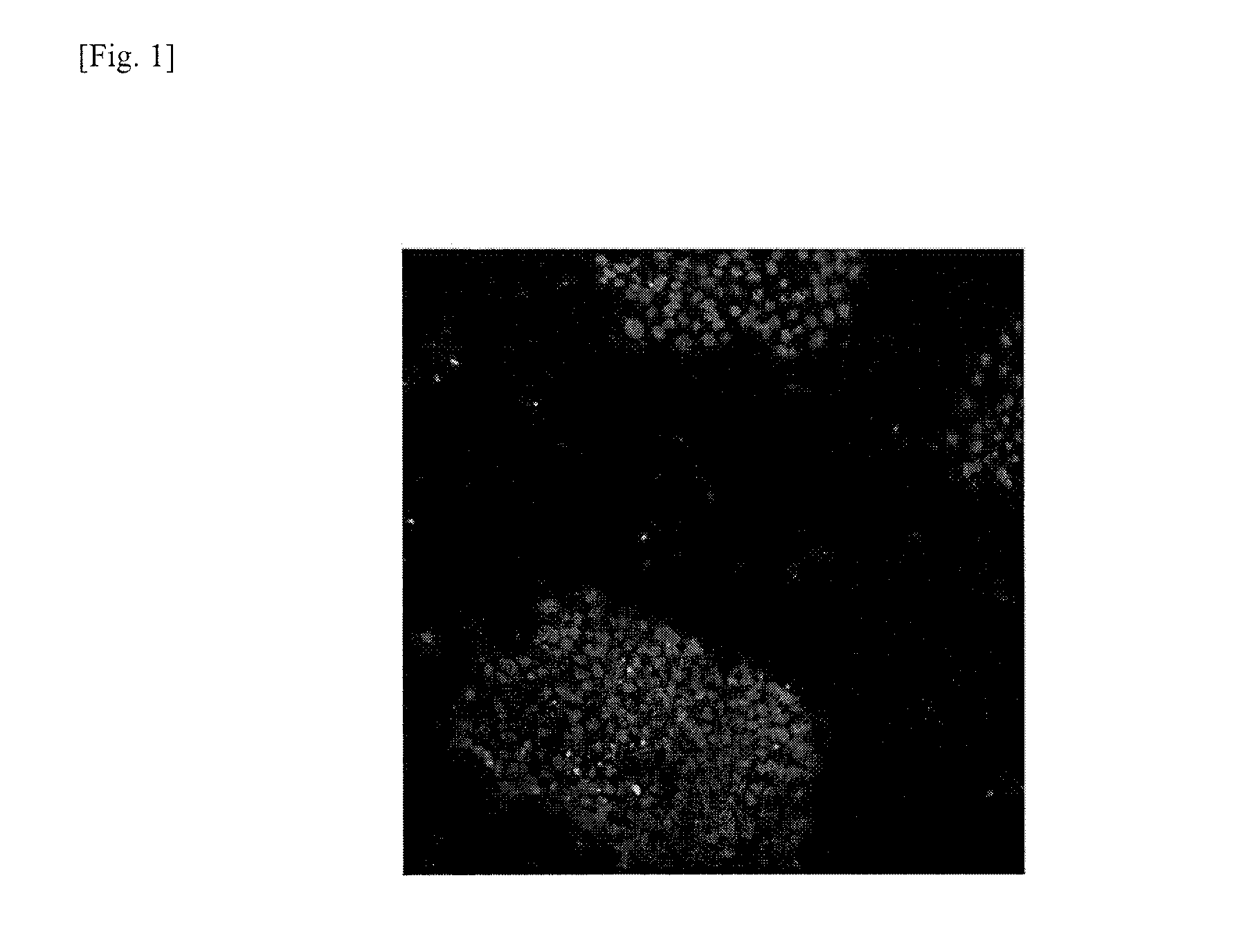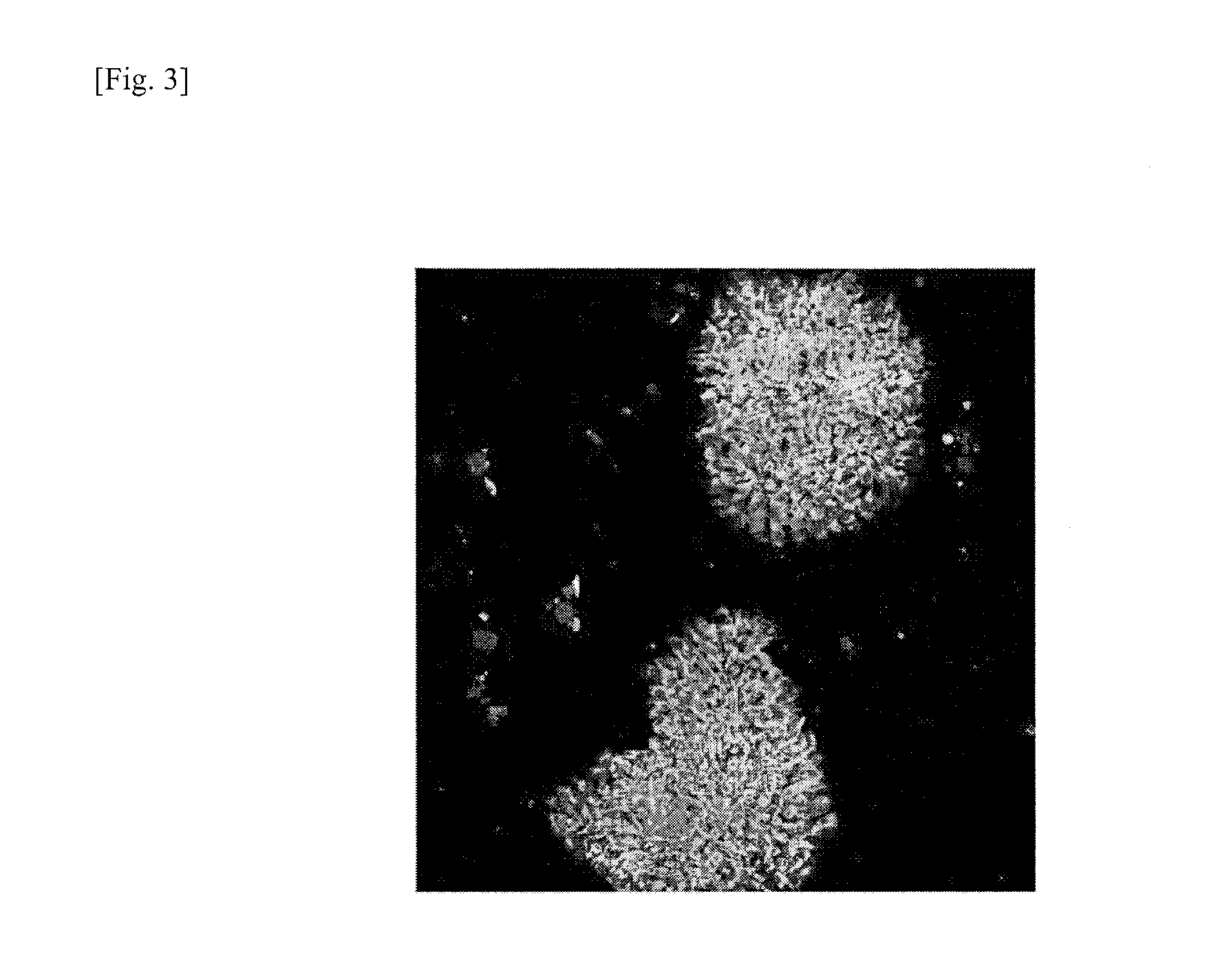Method for removing genomically unstable ips cells and synthetic peptide used therefor
a technology of genomic instability and synthetic peptide, which is applied in the direction of peptide sources, instruments, drug compositions, etc., can solve the problems of difficult to directly evaluate the genomic stability of pluripotent stem cells per se, which are actually used for regenerative therapy (i.e. living cells), and require complicated procedures or proficient skills. , to achieve the effect of increasing the expression level of calreticulin, high accuracy and high reliability
- Summary
- Abstract
- Description
- Claims
- Application Information
AI Technical Summary
Benefits of technology
Problems solved by technology
Method used
Image
Examples
example 1
Preparation of iPS Cell Culture (Subculture of iPS Cells)
[0120]The iPS cells (201B7 and 201B2) were subcultured according to the following method to prepare cultures of iPS cells. The method is detailed as follows.
[0121]SNL76 / 7 cells inactivated by treatment with mitomycin C were inoculated into a culture vessel (culture dish having a diameter of 10 cm) coated with gelatine one to four days prior to the inoculation of the iPS cells (201B7 and 201B2). The SNL76 / 7 cells were cultured at 5% CO2 and 37° C. until immediately before the inoculation of the iPS cells. Immediately before inoculation of the iPS cells on the feeder cells, the feeder cells were washed with PBS (−) (phosphate buffered saline), and the medium was replaced with a primate ES / iPS cell medium (Primate ES Cell Medium: available from ReproCELL, hereinafter also referred to as ES medium) containing 4 ng / mL of recombinant bFGF (Recombinant Basic Fibroblast Growth Factor: available from Wako Pure Chemical Industries), the...
example 2
Evaluation Test of Expression Level of Calreticulin in iPS Cells
[0124]Genomically stable iPS cells and genomically unstable iPS cells were examined for expression of calreticulin. Cells used for the test were two types of iPS cells (201B7 and 201B2). The evaluation test is detailed as follows.
[0125]The respective iPS cells (201B7 and 201B2) prepared by the method described in Example 1 were collected in a 15-mL tube in the same manner as the subculture described above, which was then left to stand for 5 minutes. Thereafter, the supernatant was removed, and iPS cell colonies were dispersed and suspended in a fresh mTeSR® medium (available from STEMCELL Technologies) using a pipette. The iPS cell suspension was then inoculated in an 8-well slide coated with Matrigel at a cell density of about 1×104 per well. The culture vessel was then incubated in an incubator overnight at 5% CO2 and 37° C. After the overnight incubation, the medium was replaced with a fresh mTeSR® 1 medium and incub...
example 3
Peptide Synthesis
[0132]Synthetic peptides having amino acid sequences SEQ ID NOs: 10 to 13 were produced with the peptide synthesiser described hereinbelow. In the following descriptions, the synthetic peptides are denoted as samples 1 to 4 according to the order of the SEQ ID NOs. Table 1 indicates information on the amino acid sequences and the like of the synthetic peptides.
TABLE 1SampleTotal aminoNo.Amino acid sequenceacid residues1KKRTLRKNDRKKR GG CRAKAGDPC 24(SEQ ID NO: 10)2KKRTLRKNDRKKR GG CEQKQEIRC 24(SEQ ID NO: 11)3KKRTLRKNDRKKR GG RAKAGDP 22(SEQ ID NO: 12)4KKRTLRKNDRKKR GG EQKQEIR 22(SEQ ID NO: 13)
[0133]As shown in Table 1, all peptides of samples 1 to 4 respectively have an amino acid sequence (SEQ ID NO: 5) derived from LIM kinase 2 at the N-terminal side of the peptide chain and respective calreticulin expression inducing peptide sequences (SEQ ID NOs: 1 to 4) C-terminal thereto via a linker region consisting of 2 glycine (G) residues.
[0134]The peptide (SEQ ID NO: 10 or...
PUM
| Property | Measurement | Unit |
|---|---|---|
| diameter | aaaaa | aaaaa |
| temperature | aaaaa | aaaaa |
| concentration | aaaaa | aaaaa |
Abstract
Description
Claims
Application Information
 Login to View More
Login to View More - R&D
- Intellectual Property
- Life Sciences
- Materials
- Tech Scout
- Unparalleled Data Quality
- Higher Quality Content
- 60% Fewer Hallucinations
Browse by: Latest US Patents, China's latest patents, Technical Efficacy Thesaurus, Application Domain, Technology Topic, Popular Technical Reports.
© 2025 PatSnap. All rights reserved.Legal|Privacy policy|Modern Slavery Act Transparency Statement|Sitemap|About US| Contact US: help@patsnap.com



